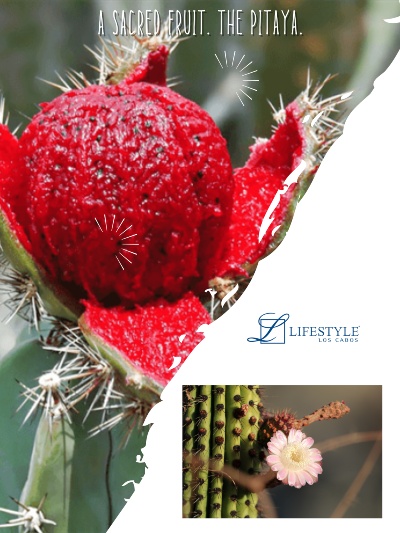
The heritage of our ancestors is often based on the memory that lives in our food. And it is nature that has been able to leave the teaching through our ancestors a relationship marked by a deep respect and reciprocity towards it. They knew that the fruits that it offered us were more than a resource to feed themselves; it meant a symbiosis between them and Mother Earth. They were grateful for the harvest seasons, which meant collecting fruits that fed them and helped them heal different ailments.
The Pitaya is one of the most emblematic fruits of Baja California Sur. This fruit was considered sacred by the indigenous peoples who inhabited the region. Even today, it is widely consumed and valued for its flavor, properties, and distinctive appearance. Many visitors are surprised by how such a delicious food can come from a cactus. Native peoples such as the Guaycuras and Cochimíes showed a deep devotion to this fruit, naming the season they could harvest it as Amada-appí. In addition, the Jesuits documented in their writings the great addiction these ethnic groups had to this delicious food.
For them, the collection of these fruits during the harvest period meant the most joyful and prosperous time of the year. The harvest begins during the rainy season, with July and August being the months of greatest abundance.This fruit grows from Ensenada (Baja California) to the southern region of Los Cabos Tourism & Lifestyle, as well as in Sonora and the islands of the Gulf of California.
If you are a fan of cacti, an emblem in our region, you will know that they produce the most beautiful flowers. They are an important Southern Californian symbol that gives its name to the regional dress. The flower of these fruits is white and fragrant. In particular, the flower of the Pitaya is the largest of all cacti.
In addition to its visual appearance, this flower emits a sweet and intoxicating aroma that attracts nocturnal pollinators such as bats. Its duration is ephemeral since it only blooms for one night, symbolizing the fleeting and the precious. The pitaya flower is not only a delight for the senses but also represents the richness of South Californian biodiversity, reflecting a deep connection between the local culture and its natural environment.
It should be noted that the word pitahaya is often confused with Pitaya, although they are related; the first is of Antillean origin and means scaly fruit; its fruit is ovoid, rounded, and elongated; its pulp can be red, white, or yellow and its seeds are small and black; its flavor is less sweet than that of the Pitaya. Meanwhile, the name pitaya is given to the fruit covered with thorns. Its fruit is a semi-rounded ovoid with white, red, yellow, purple, and red pulp and many black seeds (just like the pitahaya). Its flavor is very sweet, and its growth habit is that of a columnar cactus.
In the local culture, the Pitaya has a special place. During harvest times, communities celebrate festivals in its honor, where traditional dishes made with this fruit are tasted. Local artisans also use the image of the Pitaya in their creations, symbolizing the connection between nature and cultural identity.Thus, the Pitaya adorns the South Californian landscape with its ephemeral flower and nourishes and unites the community, being a true treasure of the region.
The Pitaya is appreciated not only for its beauty but also for its multiple nutritional benefits. Rich in antioxidants, vitamins, and minerals, it has become a popular ingredient in various recipes, from salads, juices, and artisanal ice creams to smoothies.
Once the rainy season begins, it is very common to find people on the Transpenínsular Highway selling bags full of pitayas, both red and white, which are the most common in this state, as well as snow, which gives a refreshing and delicious snack or dessert to travelers who usually pass through these routes, alleviating even a little the constant heat of the season.
Savoring and getting to know local products makes us get closer in a pleasant way to the customs of a region, and trying this fruit that was considered sacred by the ancestors of these lands has a special meaning.From Luxury LIFESTYLE Vacation Rentals Villas, we want to reveal these lands’ authentic natural and cultural roots, giving you teachings that allow you to enjoy our destination in a deeper way when you decide to visit it.
